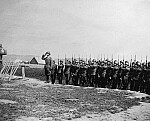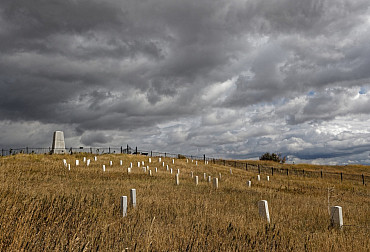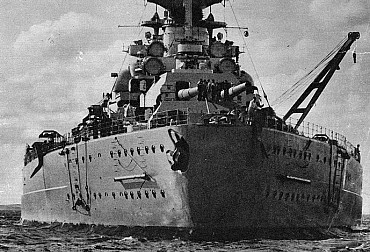November 4th 1979: Iran hostage crisis - the day that redefined U.S. and Iran relations
On November 4, 1979, one of the most significant crises in U.S. - Iran relations erupted when a group of Iranian students, radicalized by the recent Iranian Revolution, stormed the U.S. Embassy in Tehran. This event not only marked a turning point in U.S. - Iran relations but also sent shockwaves around the world, shaping diplomatic and political dynamics for decades.

The Roots of the Crisis
The U.S.-Iranian relationship had been tense long before the embassy takeover, largely due to Iran's controversial monarchy. In 1953, the CIA and British intelligence orchestrated a coup to reinstate Mohammad Reza Shah Pahlavi after he was briefly overthrown. This intervention was aimed at securing Western access to Iranian oil and limiting Soviet influence, but it deeply wounded Iranian national pride. For the next 25 years, the Shah ruled with an iron fist, maintaining a secular but increasingly repressive government that faced mounting criticism for human rights abuses, corruption, and lavish spending. As dissatisfaction grew, so did opposition groups, among them Islamic leaders like Ayatollah Ruhollah Khomeini, who openly condemned the Shah and his ties to Western powers.
In 1979, a revolution led by Khomeini and his followers overthrew the Shah, and the establishment of an Islamic Republic quickly followed. Many Iranians saw the U.S. as a puppet-master behind the Shah’s reign and despised its continued support for him. When the deposed Shah entered the U.S. for medical treatment in October 1979, outrage swept through Iran, culminating in the attack on the U.S. Embassy in Tehran.
The Embassy Takeover
On the morning of November 4, 1979, a group of Iranian students calling themselves the “Muslim Student Followers of the Imam’s Line” stormed the U.S. Embassy compound in Tehran. The students quickly overpowered embassy guards and took 66 Americans hostage, including diplomats and staff members. The embassy takeover was intended as a symbolic act of defiance against the U.S., which they accused of imperialism and interference in Iran’s affairs.
Ayatollah Khomeini, who had become Iran's Supreme Leader, endorsed the takeover. The students demanded that the U.S. extradite the Shah to Iran to face trial, which the U.S. refused, citing medical reasons and concerns about potential abuses. The hostages remained in captivity, leading to an international crisis that gripped the world’s attention.
The Hostage Crisis: 444 Days of Tension
The U.S. responded by imposing economic sanctions and diplomatic pressure on Iran. Diplomatic negotiations proved futile, and a U.S. military operation, Operation Eagle Claw, to rescue the hostages failed catastrophically, resulting in the deaths of eight American service members and further eroding confidence in the U.S. government's handling of the situation.
Throughout the 444 days of captivity, the hostages were subjected to physical and psychological abuse. They were paraded blindfolded in front of cameras and held in harsh conditions. Despite efforts by various intermediaries, including the United Nations and other international organizations, the standoff persisted, humiliating the U.S. and straining its relations with its allies.
Operation Eagle Claw
Operation Eagle Claw was highly complex, involving coordination across multiple branches of the U.S. military, which posed logistical and operational challenges. The plan included flying a team of Delta Force operatives into Iran, where they would rendezvous with C-130 transport aircraft at a desert staging area, codenamed "Desert One." From there, they intended to launch a surprise assault on the U.S. Embassy in Tehran to extract the hostages. The operation required a series of precisely timed and coordinated actions, including establishing a covert forward operating base, navigating through treacherous sandstorms, and refueling helicopters mid-mission.
Eight RH-53 Sea Stallion helicopters were selected for the operation, but the plan required a minimum of six operational helicopters to proceed. Unfortunately, mechanical issues plagued the mission from the beginning. One helicopter was grounded due to mechanical issues even before reaching the staging area, and another had to turn back due to hydraulic problems. By the time the helicopters arrived at Desert One, only five were operational.
With insufficient helicopters, the mission was called off. However, as the team prepared to depart, a tragic accident occurred. In the chaos of refueling and repositioning, a Sea Stallion helicopter collided with a C-130 transport plane, resulting in a massive explosion that killed eight U.S. service members and wounded several others. The survivors were forced to evacuate, leaving behind equipment and classified documents, and the mission ended in failure.
The failure of Operation Eagle Claw had a profound impact on the U.S. military, leading to an in-depth analysis of the operation's shortcomings. The mission highlighted deficiencies in joint-service cooperation, a lack of specialized equipment for hostage rescue, and the need for a streamlined command structure for special operations. As a result, in 1987, the U.S. military established the U.S. Special Operations Command (SOCOM) and later Joint Special Operations Command (JSOC) to enhance coordination and capabilities among the special forces.
The mission also affected the Carter administration, contributing to a perception of ineffectiveness and influencing the 1980 U.S. presidential election, in which Ronald Reagan defeated Carter. The hostages were ultimately released on January 20, 1981, just minutes after Reagan's inauguration.
Today, Operation Eagle Claw is remembered as a turning point in U.S. military history. The tragic outcome catalyzed a transformation within the military's approach to special operations, ultimately leading to the formation of elite units with enhanced capabilities and coordination. The lessons learned from this mission contributed to the success of later operations, such as the 2011 raid that led to the killing of Osama bin Laden.
The mission remains a sobering example of the complexities and risks associated with high-stakes military operations and serves as a reminder of the sacrifices made by those who risk their lives in service of their country.
The Crisis’ Resolution and Aftermath
The hostage crisis finally came to an end on January 20, 1981, coinciding with the inauguration of U.S. President Ronald Reagan. The Algiers Accords, brokered by Algeria, stipulated the release of the hostages in exchange for the unfreezing of Iranian assets and assurances that the U.S. would not interfere in Iran’s internal affairs. All 52 remaining hostages were released, and the crisis came to an end, but its legacy would leave a lasting scar on U.S.-Iran relations.
The Long-Lasting Impact
The embassy takeover and hostage crisis fundamentally changed the relationship between the U.S. and Iran, fostering a mutual distrust that has persisted into the 21st century. The U.S. imposed strict sanctions, severely affecting Iran's economy and its ability to engage in international trade. The crisis also bolstered the power of hardline factions within Iran, which continued to oppose Western influence and maintain an adversarial stance toward the U.S. The fallout from this crisis has influenced American foreign policy in the Middle East, shaped Iran's political identity, and contributed to ongoing regional tensions.
In popular culture, the crisis was immortalized by the 2012 Oscar-winning film Argo, which recounted the story of six Americans who managed to escape the embassy and found refuge in the Canadian ambassador's residence. However, the embassy takeover remains a painful reminder of the deep-seated tensions and mistrust that continue to shape U.S.-Iran relations. The events of November 4, 1979, set in motion a complex geopolitical struggle that continues to affect both nations and the broader Middle East to this day.








